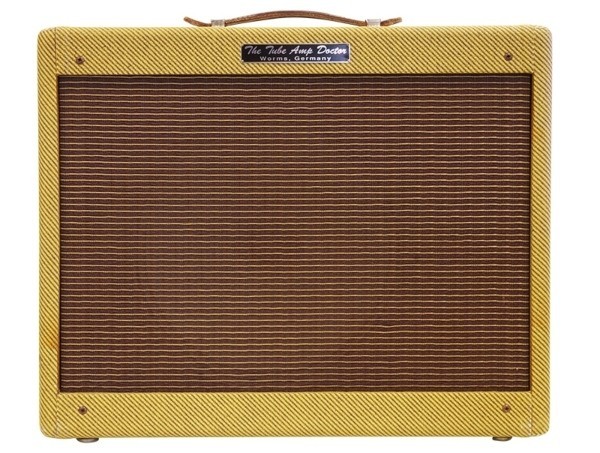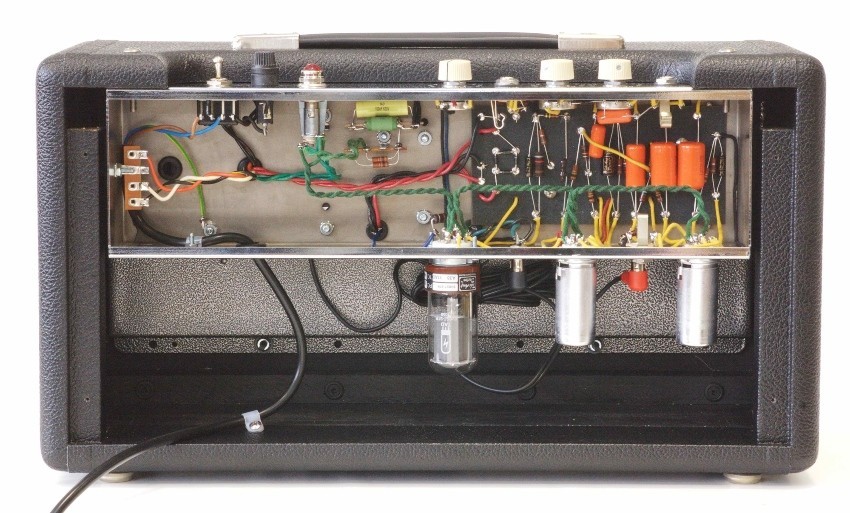« Real love of sound or just imagination? »
Hardly any other topic has been discussed as controversially as the question “tube or transistor?” for many years. It’s a fact that, aside from technical and factual differences, there are also sonic distinctions. In the following article, we aim to shed some light on an almost deadlocked discussion. Of course, we and many well-known guitarists adore the sound of a well-tuned and played tube amp above all. Nevertheless, there are situations, music genres, and occasions where a tube-based amp may not be the best choice. To make the decision and assess the particular situation, we have compiled the most important facts – enjoy!
A brief step back – of tubes and transistors
Anyone dealing with instrumental amplifiers quickly encounters the tube vs. transistor issue. But aside from sonic differences, it’s primarily the internal structure of the amplifiers that makes the difference.
Structure of a tube amplifier
To amplify the very low input signal for the speakers, tube amplifiers rely on electron tubes. These tubes work with a glowing wire that is heated by a filament. The wire emits electrons, which then strike a positively charged cathode. On their way through the vacuum of the tube, the particles are directed by grids, which also have a negative voltage. By changing the voltage, a change in current can be achieved. The signal path of a tube-based power amplifier is therefore purely analog and without many technical aids – which is why it is considered the undisputed number one by many guitarists.
Structure of a transistor amplifier
Transistor amplifiers are also designed to deliver the sound of the electric guitar to the speaker as cleanly as possible. However, they do not use analog electron tubes but rather transistors with different structures. These electronic components utilize their internal circuitry to amplify a small incoming signal and output higher current and voltage. The use of transistors consumes less energy, and the harmful heat associated with the materials used is largely eliminated. The “gentler” signal amplification achieved with transistor systems results in greater signal clarity.
Transistor vs. tube – sound differences
No point in the dispute between transistor fans and valve enthusiasts is defended more passionately than the sound of their respective systems. While the question of “good” sound is undoubtedly highly individual and subjective, the sonic differences can be described very well and precisely. We look at three key factors that are frequently discussed: warmth, dynamics, and distortion.
Transistor vs. tube – warmth
Warmth or “naturalness” in sound is often mentioned when describing the sound of a valve amp. In fact, there are differences in this characteristic between transistors and electron tubes. The reason for these differences lies in the so-called harmonics. Both amplifiers reproduce harmonics, with tube amplifiers doing so to a greater extent. However, it’s the nature of the harmonics that makes the big difference – the harmonics of tubes, due to their analog origin, sound more pleasing and “rounded” to the human ear.
Transistor vs. tube – dynamics
In the context of instrumental amplifiers, dynamics refer to how the amplifier handles variations in playing style and technique. In both the preamp and power amp stages, the amplifier’s response to different signal strengths is crucial, as is the case with distortion, which we’ll discuss later. Tube amplifiers are generally quite sensitive when it comes to signal strength. Even small voltage spikes can lead to the amplifier distorting. What frustrated jazz guitarists in the 1950s and 1960s has become popular today, especially among rock and metal guitarists – playing with the onset of distortion and changing volumes.
Summary of dynamics
Due to their sensitive nature, electron tubes translate differences in playing technique and style more quickly and vividly. Transistor amplifiers are less susceptible to such subtleties and offer a “smoother” sound.
Transistor vs. tube – distortion
Here it is, the elephant in the room. “Tube distortion,” “saturation,” and “creamy overdrive” are terms that are often used when discussing the different approaches to signal distortion. What is an absolute no-go criterion for hi-fi amplifiers is practically worshiped in guitar amps. We’re talking about signal distortion, which is essential in modern blues and rock styles. Overdrive refers to how an amplifier behaves when handling signal peaks: The incoming signal from an instrument is never uniform but is influenced by the force of the attack, guitar circuits, and effects pedals. The way transistors and tubes handle these signal peaks differs. While electron tubes round off the highest peaks (known as soft clipping), transistors do not reproduce the peaks but cut them off (clipping). Therefore, the tonal character of a transistor is generally harsher and harder.
Summary of signal distortion
Signal distortion describes how a system handles signal peaks and is handled differently by tubes and transistors. Tubes are more susceptible to signal peaks and reach saturation earlier, while transistors stay cleaner for longer. If a loud clean signal is desired, transistors provide more headroom. If a pleasantly round and warm distortion is sought, the valve amplifier has the edge. The choice also depends on the desired music genre, which is why well-known guitarists from different genres often swear by different devices.

Transistor vs. tube – pros and cons
As much as subjective impressions of tubes and transistors differ, there are objective advantages and disadvantages of each technology that we would like to briefly list below.
Advantages and disadvantages of tube amplifiers
Many things speak in favor of tube amplifiers, but not everything. Here’s an overview:
Pro
- saturation and distortion create a warm sound character
- dynamic response to changes in attack and playing, better impulse response
- fewer active components
- valve replacement allows for an expansion/change of sound character
Contra
- increased energy consumption
- significant heat generation
- usually higher weight
- more complex manufacturing leads to higher prices
- valve wear increases maintenance requirements
Advantages and disadvantages of transistor amplifiers
Transistor amplifiers also have their own characteristics. Here’s an overview of the advantages and disadvantages of this technology.
Pro
- lower price
- sound is particularly neutral and has ample clean headroom
- low wear and low maintenance requirements
- low harmonic distortion/fewer overtones
- lower energy consumption
- less weight

Contra
- less warm, natural sound
- harmonic distortion increases sharply and steeply under overload
- less dynamic and responsive
- saturation is not sufficient for “true” distortion
Transistor vs. tube – conclusion
So, there are the objective differences between transistor and tube amplifiers. In most cases, amps with tube preamps and power amps have the upper hand when it comes to tone and sound. However, analogue guitar amplifiers are less practical due to higher maintenance requirements and more vulnerable technology, which still deters many guitarists. When choosing the right guitar amplifier, factors other than sound and tone also come into play. But whenever possible, we strongly believe: There’s nothing like the right sound! And it sounds even better with equipment from TubeAmpDoctor!
___________________________________________________________________________________________________________________________
Image sources:
Title image: © cristianstorto – stock.adobe.com
Guitarist plays sitting: © sumnersgraphicsinc – stock.adobe.com
Standing guitarist: © evannovostro – stock.adobe.com
 Tubeampdoctor Magazin
Tubeampdoctor Magazin




